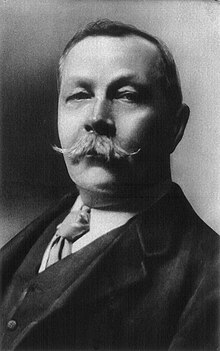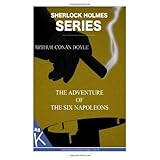About the Book: "The Adventure of the Six Napoleons", one of the 56 Sherlock Holmes short stories written by British author Sir Arthur Conan Doyle, is one of 13 stories in the cycle collected as The Return of Sherlock Holmes.
About the Author: Arthur Ignatius Conan Doyle was born on 22 May 1859 at 11 Picardy Place, Edinburgh, Scotland. From 1876 to 1881, he studied medicine at the University of Edinburgh, including a period working in the town of Aston (now a district of Birmingham) and in Sheffield, as well as in Shropshire at Ruyton-XI-Towns. While studying, Doyle began writing short stories. His earliest extant fiction, "The Haunted Grange of Goresthorpe", was unsuccessfully submitted to Blackwood's Magazine. His first published piece "The Mystery of Sasassa Valley", a story set in South Africa, was printed in Chambers's Edinburgh Journal on 6 September 1879. On 20 September 1879, he published his first non-fiction article, "Gelsemium as a Poison" in the British Medical Journal. In 1882 he joined former classmate George Turnavine Budd as his partner at a medical practice in Plymouth, but their relationship proved difficult, and Doyle soon left to set up an independent practice. Arriving in Portsmouth in June of that year with less than £10 (£900 today) to his name, he set up a medical practice at 1 Bush Villas in Elm Grove, Southsea. The practice was initially not very successful. While waiting for patients, Doyle again began writing stories and composed his first novels, The Mystery of Cloomber, not published until 1888, and the unfinished Narrative of John Smith, which would go unpublished until 2011. He amassed a portfolio of short stories including "The Captain of the Pole-Star" and "J. Habakuk Jephson's Statement", both inspired by Doyle's time at sea, the latter of which popularized the mystery of the Mary Celeste and added fictional details such as the perfect condition of the ship (which had actually taken on water by the time it was discovered) and its boats remaining on board (the one boat was in fact missing) that have come to dominate popular accounts of the incident. Doyle struggled to find a publisher for his work. His first significant piece, A Study in Scarlet, was taken by Ward Lock Co. on 20 November 1886, giving Doyle £25 for all rights to the story. The piece appeared later that year in the Beeton's Christmas Annual and received good reviews in The Scotsman and the Glasgow Herald. The story featured the first appearance of Watson and Sherlock Holmes, partially modeled after his former university teacher Joseph Bell. Doyle wrote to him, "It is most certainly to you that I owe Sherlock Holmes ... Round the center of deduction and inference and observation which I have heard you inculcate I have tried to build up a man." Robert Louis Stevenson was able, even in faraway Samoa, to recognize the strong similarity between Joseph Bell and Sherlock Holmes: "My compliments on your very ingenious and very interesting adventures of Sherlock Holmes. ... Can this be my old friend Joe Bell?" Other authors sometimes suggest additional influences—for instance, the famous Edgar Allan Poe character C. Auguste Dupin. A sequel to A Study in Scarlet was commissioned and The Sign of the Four appeared in Lippincott's Magazine in February 1890, under agreement with the Ward Lock company. Doyle felt grievously exploited by Ward Lock as an author new to the publishing world and he left them. Short stories featuring Sherlock Holmes were published in the Strand Magazine. Doyle first began to write for the 'Strand' from his home at 2 Upper Wimpole Street, now marked by a memorial plaque. In this period, however, Holmes was not his sole subject and in 1893, he collaborated with J.M. Barrie on the libretto of Jane Annie. Doyle was found clutching his chest in the hall of Windlesham Manor, his house in Crowborough, East Sussex, on 7 July 1930. He died of a heart attack at the age of 71. His last words were directed toward his wife: "You are wonderful." At the time of his death, there was some controversy concerning his burial place, as he was avowedly not a Christian, considering himself a Spiritualist. He was first buried on 11 July 1930 in Windlesham rose garden. He was later re-interred together with his wife in Minstead churchyard in the New Forest, Hampshire. Carved wooden tablets to his memory and to the memory of his wife are held privately and are inaccessible to the public. That inscription reads, "Blade straight / Steel true / Arthur Conan Doyle / Born May 22nd 1859 / Passed On 7th July 1930." The epitaph on his gravestone in the churchyard reads, in part: "Steel true/Blade straight/Arthur Conan Doyle/Knight/Patriot, Physician, and man of letters". Undershaw, the home near Hindhead, Haslemere, south of London, that Doyle had built and lived in between October 1897 and September 1907, was a hotel and restaurant from 1924 until 2004. It was then bought by a developer and stood empty while conservationists and Doyle fans fought to preserve it. In 2012 the High Court ruled that the redevelopment permission be quashed because proper procedure had not been followed. A statue honors Doyle at Crowborough Cross in Crowborough, where he lived for 23 years. There is also a statue of Sherlock Holmes in Picardy Place, Edinburgh, close to the house where Doyle was born.
My Review: In this story, Inspector Lestrade of Scotland Yard brings Holmes a seemingly trivial problem about a man who shatters plaster busts of Napoleon. One was shattered in Morse Hudson’s shop, and two others, sold by Hudson to a Dr. Barnicot, were smashed after the doctor’s house and branch office had been burgled. Nothing else was taken. In the former case, the bust was taken outside before being broken.
Holmes knows that Lestrade’s theory about a Napoleon-hating lunatic must be wrong. The busts in question all came from the same mould. Why is he breaking them?
The next day, Lestrade calls Holmes to a house where there has been yet another bust-shattering, but there has also been a murder. Mr. Horace Harker found the dead man on his doorstep after investigating a noise. His Napoleon bust was also taken by a burglar entering through a window. It, too, was from the same mould. Also, a photograph of a rather apish-looking man is found in the dead man’s pocket.
The fragments of Harker's bust are in the front garden of an empty house up the street. Obviously the burglar wanted to see what he was doing, for there is a streetlamp here, whereas the bust could have been broken at another empty house nearer Harker’s, but it had been dark there.
Holmes tells Lestrade to tell Harker, a journalist for the Central Press Syndicate, that he is convinced that the culprit is a lunatic. Holmes knows that this is not true, but it is expedient to use the press to convince the culprit that this is what the investigators believe.
Holmes interviews the two shopkeepers who sold the busts and finds out whom they were sold to, and where they were made, Gelder & Co. A couple of his informants also recognize the apish man in the picture. They know him as Beppo, an Italian immigrant. He even worked in the shop where the first bust was broken, having left his job there only two days earlier.
Holmes goes to Gelder & Co. and finds out that the busts were part of a batch of six, but other than that, the manager can think of no reason why they should be special, or why anyone would want to destroy them. He recognizes Beppo’s picture, and describes him as a rascal. He was imprisoned for a street-fight stabbing a year earlier, but has likely been released now. He once worked at Gelder & Co., but has not been back. His cousin still works there. Holmes begs the manager not to talk to the cousin about Beppo.
That evening, Lestrade brings news that the dead man has been identified as Pietro Venucci, a Mafioso. Lestrade believes that Venucci was sent to kill Beppo, but wound up dead himself. Why is the Mafia after Beppo?
After sending an express message, Holmes invites Dr. Watson and Lestrade to join him outside a house in Chiswick where apparently Holmes is expecting another bust-breaking. Lestrade by now is exasperated with Holmes’s preoccupation with the busts, but comes. They are not disappointed. Beppo shows up, enters the house, and comes back out of the window minutes later with a Napoleon bust, which he proceeds to shatter. He then examines the pieces, quite unaware that Holmes and Lestrade are sneaking up behind him. They pounce, and Beppo is arrested. He will not talk, however.
The mystery is at last laid bare after Holmes offers £10 to the owner of the last existing bust, making him sign a document transferring all rights and ownership of the bust to Holmes. After the seller has left, Holmes smashes the bust and among the plaster shards is a gem, the black pearl of the Borgias. Holmes was aware of the case of its disappearance from the beginning. Suspicion had fallen on the owner’s maid, whose name was Lucretia Venucci – the dead man’s sister. Beppo somehow got the pearl from Pietro Venucci, and hid it inside a still-soft plaster bust at the factory where he worked, moments before his arrest for the street-fight stabbing.
After serving his one-year sentence, he sought to retrieve the hidden pearl. He found out from his cousin who bought the busts, and through his own efforts and confederates’, even found out who the end buyers were. He then proceeded to seek the busts out, smashing them one by one to find the pearl.
Although he appears in later published works, this is one of Lestrade's last appearances within the canon. After this he is only mentioned by Holmes or Watson, in "The Disappearance of Lady Frances Carfax" and "The Adventure of the Three Garridebs" as a working member of the Yard.
I recommend this book to all readers who appreciate a well written mystery story, mainly for those who love Sherlock Holmes.
I recommend this book to all readers who appreciate a well written mystery story, mainly for those who love Sherlock Holmes.




No comments:
Post a Comment